The NVIDIA SHIELD Tablet Review
by Joshua Ho on July 29, 2014 9:00 AM ESTBattery Life
As always, battery life is one of the most important aspects of any mobile device, and is crucial to staying mobile. There’s not much introduction needed to this, as it’s rather well understood that more battery life is usually better. The Shield tablet features an integrated 19.75Wh battery.
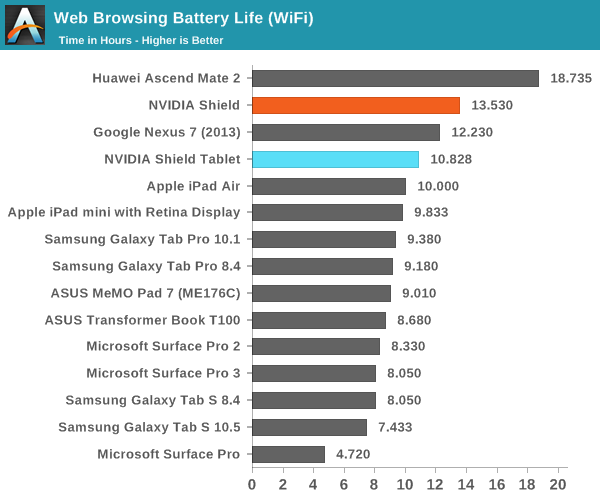
This device is a tablet first and foremost, so WiFi browsing battery life is important. In this area, the tablet does well. However, it’s a bit strange how the device performs worse than the Nexus 7 (2013). The reason why I say this is that the Tegra K1 is on a far more power efficient process (28HPm), has broadly equivalent battery capacity to screen area scaling, and should have a more power efficient display due to the reduced gamut. However, it could be that Cortex A15 just isn’t as power efficient as Krait and the silicon backplane of the display isn’t as efficient as the one in the Nexus 7.
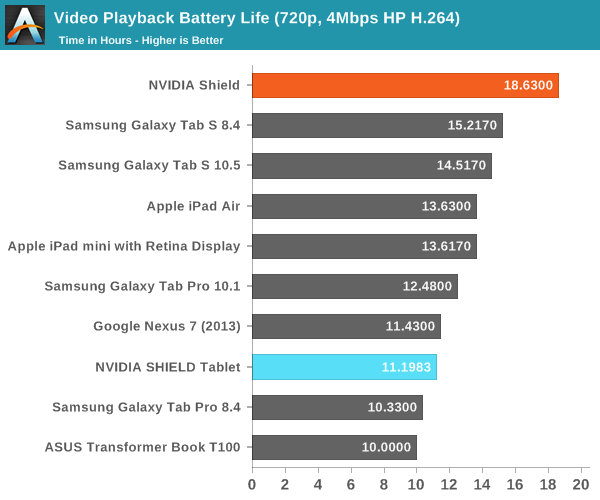
While normally web browsing tests are enough to cover the relatively low-compute use cases for smartphones, video playback is a significant use case for tablets. Here, we see that the gap between the Nexus 7 (2013) and the SHIELD Tablet narrows significantly, which can probably be attributed to the mostly display-bound nature of this test. Due to the much lower APL average of this test, we see that the Galaxy Tab S line does noticeably better in this test because their AMOLED displays mean that black-heavy content dramatically reduces power draw. This is because a black pixel in an AMOLED display is turned off and doesn't consume power, while an LCD display relies on a backlight so it isn't possible to turn off the backlight for a single pixel without turning off the entire display.

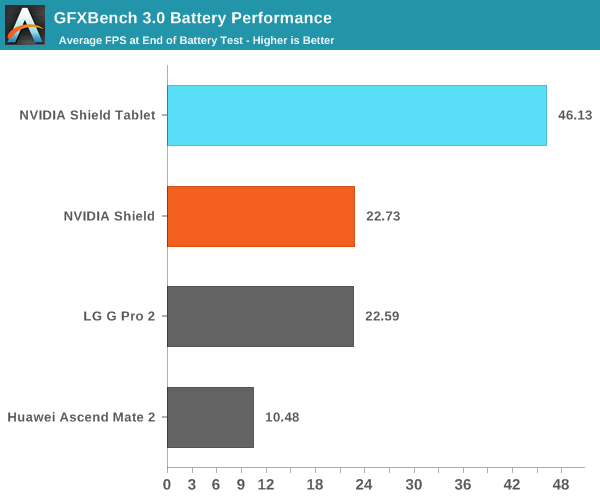
Of course, the Shield Tablet is also designed for gaming. Unfortunately, the Tegra K1 introduces quite a massive amount of dynamic range. While it’s fully possible for the Shield tablet to last 10 hours of continuous use on a single charge, running the GPU at full blast gives battery life similar to a gaming laptop. Realistically, if a game is made for Tegra K1 and truly stretches the GPU to the limit, battery life is only around two and a half hours, assuming display brightness is kept down to 200 nits. Of course, anything less intensive will do much better.
NVIDIA has also made it possible to cap the maximum frame rate and clock speed for better battery life. However, it’s quite clear in this test that the tablet isn’t capable of sustaining peak performance the way the Shield portable was, as the Shield portable sustained around 90% of the first run performance while the tablet sustained around 80% of its first run performance. The Shield Tablet also has noticeably higher skin temperatures, although this was a subjective observation.


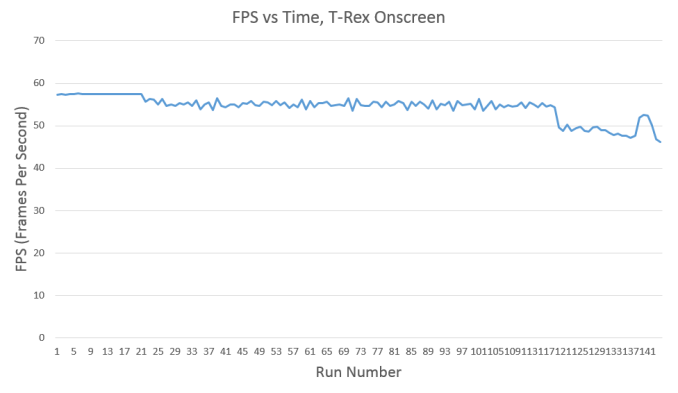
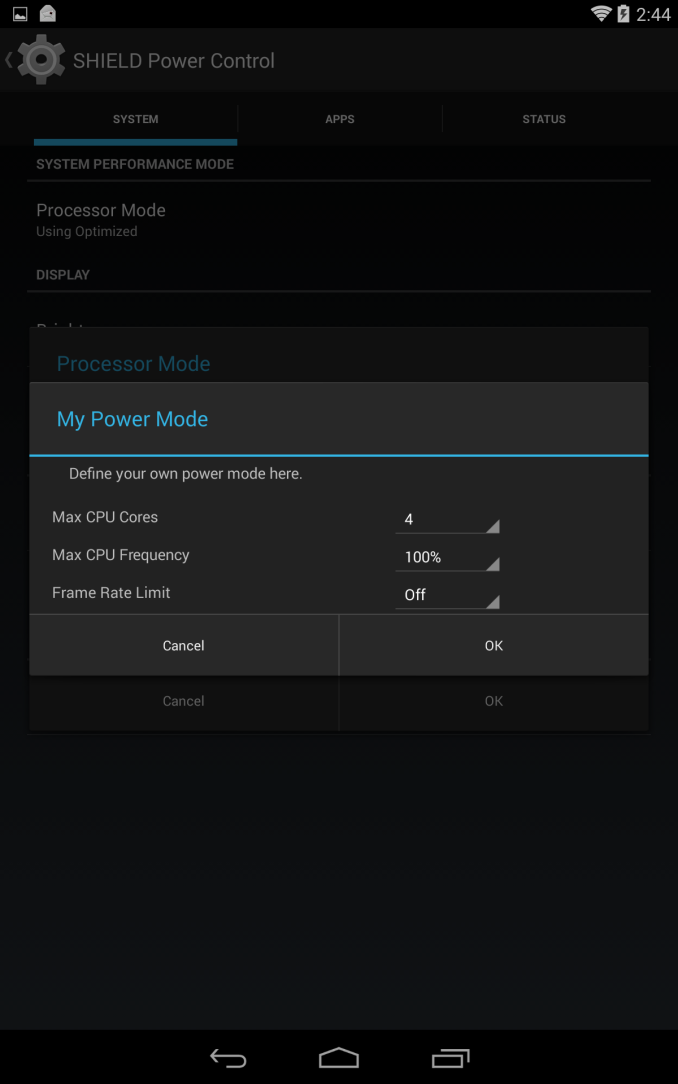
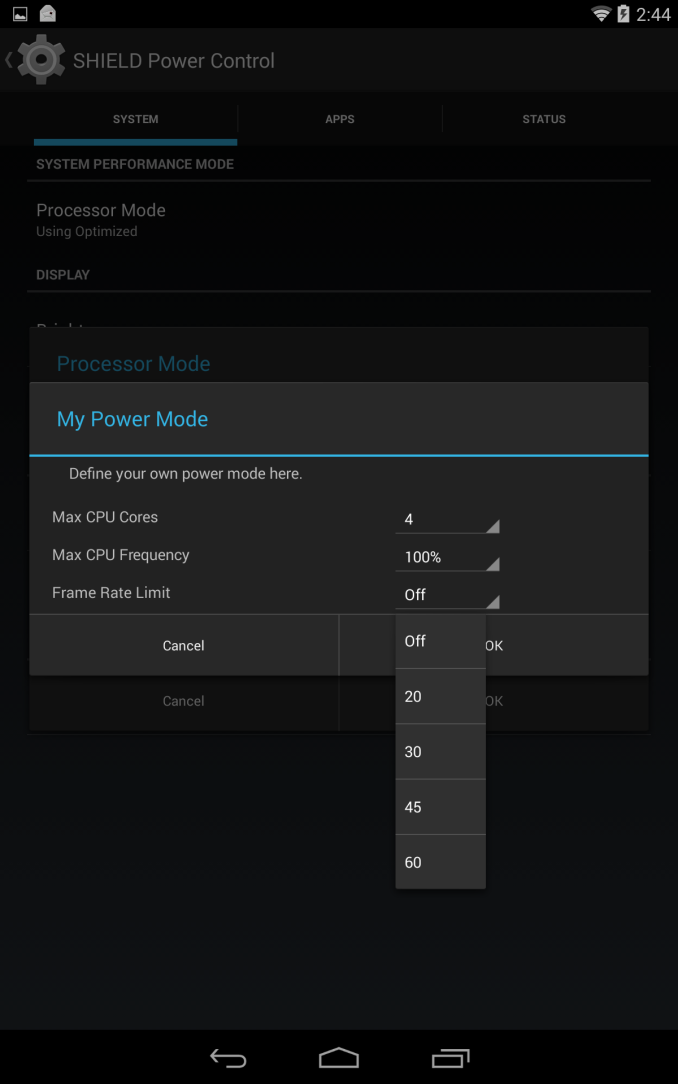








174 Comments
View All Comments
Stuka87 - Tuesday, July 29, 2014 - link
I think the tablet on its own is decent. Although it is very heavy for its size (Which BTW this review does not mention its weight anywhere).The controller is what I end up scratching my head over. In their release photos they show a girl gaming with the tablet, but sitting like 3ft away. As if being that far away would be enjoyable.
One other thing that is not clear, if the tablet is NOT on wifi, will the controller still work? The article makes it sound like you have to be on wifi.
Friendly0Fire - Tuesday, July 29, 2014 - link
WiFi *Direct* is a straight connection between the tablet and the controller using the WiFI protocol. It most certainly doesn't need a network to work.Stuka87 - Tuesday, July 29, 2014 - link
Hm, ok. But he specifically said it depends what type of wifi network you are on.lmcd - Tuesday, July 29, 2014 - link
That's for the connection band. Meaning that if one of the two Wi-Fi bands is in use for Wi-Fi, then the other one is the one that'll be used for the Wi-Fi direct.halca - Tuesday, July 29, 2014 - link
Really? That's it for the directstylus review section? I'm disappointed. I hoped to see more comparison between the old and new, and compared to wacom's tech on samsung note line.scbundy - Tuesday, July 29, 2014 - link
Shame about the screen, but with my old Nexus 7 broken and me looking for a gaming tablet replacement, this one appears to fit the bill perfectly. Especially since my gaming PC has a 780 GTX. Can't wait to try it out.dabotsonline - Tuesday, July 29, 2014 - link
"In essence, this device is already ready to serve as an Android TV device."I thought that Google are mandating a very specific UI design for Android TV devices - one which is very different from this? Do you have any inside info regarding the final version this fall / autumn, Josh?
aamir147 - Tuesday, July 29, 2014 - link
I think he means nvidia can eventually add an android TV mode when connecting via hdmi just like you can get a console mode.SpartyOn - Tuesday, July 29, 2014 - link
Personally, I love my Shield Portable (or whatever they're calling the 1st Gen device). Sitting in bed or on the couch streaming the game I just turned off at my desk is fantastic. It's also the best Android emulator device out there.The recent updates to allow outside the home streaming (which this article incorrectly states as only allowing in-home; please change) and 1080p Console Mode streaming via wired Ethernet, have made this a killer mobile gaming device. Instead of carting my mITX build back and forth when I want to play a game via controller on my HDTV, I can now simply hook up the Shield and stream the game, in full 1080p, to the TV and can hook up an XBOX 360 wireless controller with USB OTG. No more hauling a computer around the house or having to settle for a laptop! Seriously awesome.
My wife and I continuously fight to use the Shield when heading to bed, she for her emulators and me for streaming from my gaming rig. I REALLY want to pick up another one so that she can have her own, so I was hoping this was going to be a self-contained device like the 1st Gen, just with the K1 and maybe some weight balancing, an extra miniUSB port, and a 6" screen with less bezel (the bezel with the 5" is HUGE and I'm sure they could creatively get a slightly bigger screen in there).
Unfortunately, the new Shield device as a tablet is... underwhelming. Sure it has snazzy bells n' whistles for a tablet, but with the larger form factor and lack of handholding ease, this really kills a lot of its portability. I prefer the fully contained controller/screen of the original; plus, it was different and really created a new market. Now it's just another tablet in a crowded field. Seems like a dumb strategy to me.
Until they release a refreshed Shield Portable with the K1, I'll be keeping my money. Kudos to NVIDIA though for the 1st Gen device - I love it.
fivefeet8 - Tuesday, July 29, 2014 - link
Unfortunately, you're probably in the minority at this point and I do understand why some would prefer it that way. One of the reasons I didn't get the original shield is because you couldn't do much else with it besides gaming. Even though I loved the hardware and software, I wanted something that could encompass more. Something I could use for both work and play on mobile. The new Shield Tablet fits that almost perfectly.